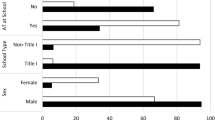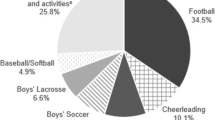Abstract
Background
The purpose of this study was to identify if knowledge of concussion differences exists between communities that service underserved, African-American athletes compared to white athletes, and to explore differences in concussion knowledge between African-American and white athletes with and without access to an athletic trainer.
Methods
Five hundred seventy-seven adolescent athletes ranging in age from 13 to 18 from 14 schools in the USA completed a one-time pencil and paper survey instrument. Data were collected from September 2014 to April 2015. All athletes included in the study received concussion education implemented (i.e., Centers for Disease Control and Prevention (CDC) Heads UP documents) by state concussion law. Knowledge of concussion scores were determined by summing the total correct responses to the 35 questions. Race (white or African-American) and access to an athletic trainer were the independent variables explored.
Results
White high school athletes have increased concussion knowledge compared to African-American athletes (p < 0.001). African-American athletes less frequently recognized all correct signs and symptoms of concussion compared to white athletes. African-American athletes with access to an athletic trainer have more knowledge than African-American athletes without access to an athletic trainer (p = 0.003).
Conclusions
White athletes had more concussion knowledge than African-American athletes; however, African-Americans that had access to an athletic trainer at their respective school were more likely to identify the signs and symptoms of concussion compared to African-Americans that did not have access to an athletic trainer. This further accentuates the health disparity that occurs in high school athletics, in regard to the presence of an athletic trainer and their influence on an athlete’s health and safety.
Similar content being viewed by others
References
Langlois JA, Rutland-Brown W, Thomas KE. The incidence of traumatic brain injury among children in the United States: differences by race. J Head Trauma Rehabil. 2005;20(3):229–38.
McCrory P, Meeuwisse WH, Aubry M, Cantu RC, Dvorak J, Echemendia RJ, et al. Consensus statement on concussion in sport: the 4th international conference on concussion in sport held in Zurich, November 2012. Br J Sports Med. 2013;47:250–8.
Centers for Disease Control and Prevention Web site. Concussion and mild TBI. www.cdc.gov/concussion/ Published October 6, 2011. Accessed October 15, 2014.
Dompier TP, Kerr ZY, Marshall SW, Hainline B, Snook EM, Hayden R, et al. Incidence of concussion during practice and games in youth, high school, and collegiate American football players. JAMA Pediatr. 2015;169:659–65.
Gessel LM, Fields SK, Collins CL, Dick RW, Comstock RD. Concussions among United States high school and collegiate athletes. J Ath Train. 2007;42(4):495–503.
Asken BM, McCrea MA, Clugston JR, et al. “Playing through it”: delayed reporting and removal form athletic activity after concussion predicts prolonged recovery. J Athl Train. 2016;51(4):329–35.
Cantu RC. Second impact syndrome. Clin Sports Med. 1998;17(1):37–44.
Cantu RC, Gean AD. Second-impact syndrome and a small subdural hematoma: an uncommon catastrophic result of repetitive head injury with a characteristic imaging appearance. J Neuro-Oncol. 2010;27(9):1557–64.
Jager TE, Weiss HB, Coben JH, et al. Traumatic brain injuries evaluated in US emergency departments, 1992–1994. Acad Emerg Med. 2000;7:134–40.
Selassie AW, Pickelsimer EE, Frazier L, et al. The effect of insurance status, race, and gender on ED disposition of persons with traumatic brain injury. Am J Emerg Med. 2004;22(8):465–73.
Kontos AP, Elbin III RJ, Covassin T, et al. Exploring differences in computerized neurocognitive concussion testing between African American and white athletes. Arch Clin Neuropsych. 2010;25:734–44.
Watson BC. Problems and potentials in urban education. J Negro Educ. 1989;58(3):309–14.
Haider AH, Efron DT, Haut ER, et al. Black children experience worse clinical and functional outcomes after traumatic brain injury: an analysis of the National Pediatric Trauma Registry. J Trauma. 2007;62(5):1259–62.
Bazarian JJ, Pope C, McClung J, et al. Ethnic and racial disparities in emergency department care for mild traumatic brain injury. Acad Emerg Med. 2003;11(1):1209–17.
United States Census Bureau Web site. http://quickfacts.census.gov/qfd/states/39/3988000.html Updated October 14, 2015. Accessed November 1, 2015.
National Collegiate Athletic Association. Sport sponsorship, participation, and demographics search [cited 2016 July 31]. Available from: http://web1.ncaa.org/rgdSearch/exec/saSearch
Marar M, McIlvain NM, Fields SK, et al. Epidemiology of concussions among United States high school athletes in 20 sports. Am J Sports Med. 2012;40:747–55.
Vicente, R. Race & ethnicity: 199,900, 2004–05 NCAA Student-Athlete Race and Ethnicity Report. Retrieved October 8, 2015 from http://www.ncaa.org/library/research/ethnicity_report/2004-05/2004-05_race_ethnicity_report.pdf.
Coakley J. Sport in society: issues and controversies. 9th ed. New York: McGraw-Hill; 2007.
Register-Mihalik JK, Guskiewicz KM, McLeod TC, Linnan LA, Mueller FO, Marshall SW. Knowledge, attitude, and concussion-reporting behaviors among high school athletes: a preliminary study. J Athl Train. 2013;48(5):645–53.
Cournoyer J, Tripp B. Concussion knowledge in high school football players. J Athl Train. 2014;49(5):654.
Wallace, J., Covassin, T., Nogle, et al. Knowledge of concussion and reporting behaviors in high schools with and without an athletic trainer. J Athl Train. 2017.
Gourley, M.M., Valovich-McLeod, T., Bay, R.C. Awareness and recognition of concussion by youth athletes and their coaches. ATSHC. 2010. 1–11.
Centers for Disease Control and Prevention Heads UP. Cited November 1, 2016. Available at http://www.cdc.gov/headsup/highschoolsports/
Bloodgood B, Inokuchi D, Shawver W, Olson K, Hoffman R, Cohen E, et al. Exploration of awareness, knowledge, and perceptions of traumatic brain injury among American youth athletes and their parents. J Adolesc Heatlh. 2013;53:34–9.
Valovich McLeod TC, Huxel Bliven KC, Lam KC, et al. The national sports safety in secondary schools benchmark (N4SB) study: defining athletic training practice characteristics. J of Athl Train. 2013;48(4):483–92.
Broglio SP, Cantu R, Gioia GA, et al. National athletic trainers’association position statement: management of sport concussion. J of Ath Train. 2014;49(2):245–65.
Acknowledgements
This project was supported by grants from the Pentacost Foundation, Blue Cross Blue, Shield of Michigan Foundation, and Michigan State University Graduate School.
Author information
Authors and Affiliations
Corresponding author
Ethics declarations
The authors have no conflict of interest to report. All procedures performed in this study involving human participants were in accordance with the ethical standards of the institutional and with the 1964 Helsinki declaration and its later amendments or comparable ethical standards. Informed consent was obtained from all individual participants included in the study.
Rights and permissions
About this article
Cite this article
Wallace, J., Covassin, T. & Moran, R. Racial Disparities in Concussion Knowledge and Symptom Recognition in American Adolescent Athletes. J. Racial and Ethnic Health Disparities 5, 221–228 (2018). https://doi.org/10.1007/s40615-017-0361-1
Received:
Revised:
Accepted:
Published:
Issue Date:
DOI: https://doi.org/10.1007/s40615-017-0361-1




